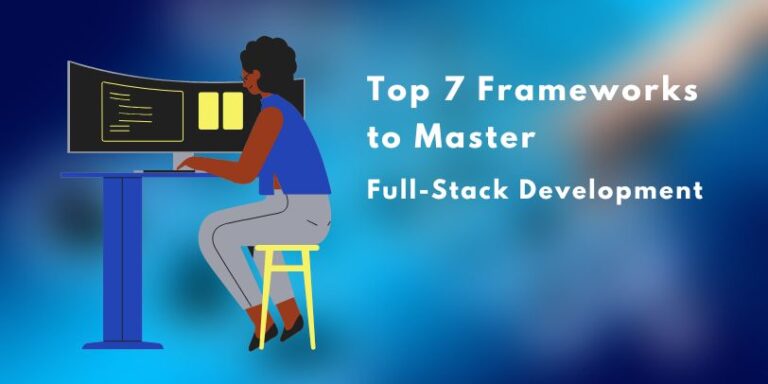Regardless of the industry, there are always certain aspects that can accelerate the overall growth of a sector. In the case of the software development industry, it’s the art of coding that facilitates it. This is a whole new dimension that is powered by several technologies, tools, and frameworks.
At the moment, one of the most popular ways to sail through the complexities of coding is by using full-stack frameworks that are designed to program complicated software without manually creating generic codes from scratch. To put it simply, they use pre-written codes to process, input, and manage software development.
The Most Popular Frontend and Backend Full-stack Frameworks
If you are one of those aspiring developers who want to be well-acquainted with multiple frameworks and have a competitive edge in a pool of talent, you might be searching for the most popular full-stack development services and frameworks. Luckily, we have curated alist of leading full-stack frameworks for you. Continue reading…
1. AngularJS
Angular is a JavaScript-based front-end framework created by Google. It simplifies the development and testing of part of single-page applications and provides a framework for MVC and MVVM architectures. Another reason is its modularity trait, which allows and enables you to create multiple modules easily for a single app.
The framework comes with some great documentation and plugins that make it a great choice among developers offering full-stack development services. If you don’t want to go for the React full-stack framework, then Angular is your alternative.
Used by: Google, Fobes, Paypal, and Upwork.
2. Spring Boot
Developed by the Pivotal Team, the Spring Boot framework is also popular among full-stack development companies around the world. This is because it has the ability to reduce the overall development time. This framework solves coding issues associated with using Spring for Java web development.
For instance, it introduces auto-configuration and Starter dependencies to alleviate the pain of Java developers that often spend a significant amount of time configuring Spring and finding a set of compatible libraries to work together. As a result, Spring Boot improves productivity and makes the process of creating micro services easier and faster.
Used by: Udemy, ViaVarejo, and trivago.
3. ReactJS
Officially declared as the most widely used web development framework among developers, ReactJS is an open-source, front-end JavaScript library for creating user interfaces. As a full-stack technology, it is used as a base for building mobile apps or single-page apps. It allows you to build reusable UI components with utter simplicity, scalability, and flexibility.
If you are familiar with JavaScript, then learning ReactJS should be your top choice for successful frontend development. You can build fast and interactive interfaces for both website and mobile apps without depending on any other framework.
Used by: Facebook, Netflix, Asana, and Dropbox.
4. Django
Named after Django Reinhardt, who was a famous French composer and guitarist, Django is a Python-based framework that follows the architectural pattern of MVC (model-view-controller). This is a free and open-source framework, which was primarily designed to promote quicker development with interactive designs.
What makes Django special is the fact that it can be used to develop almost any kind of website, whether it’s a content management system (CMS) or a social network. On top of that, it is compatible with any client-side framework and can deliver content in almost every format.
Used by: Instagram, Mozilla, and Nextdoor.
5. Rails
Often known as Ruby on Rails, Rails is a back-end framework based on the Ruby language. The framework is widely popular among full-stack development companies, as it contains an MVC architecture and can facilitate the usage of HTML, JS, and CSS to build powerful interfaces.
The framework emphasizes Convention over Configuration (CoC) and Don’t Repeat Yourself (DRY) patterns. It also supports ‘less code and less repetition’ and is not connected to the internet directly. You can run it with Nginx, Apache and Cherokee, etc.
Used by: Airbnb, Bloomberg, and GitHub.
6. NodeJS
NodeJS is another open-source framework built on the JavaScript V8 engine. It is an extremely popular choice for server-side coding and can run in NodeJS runtime on Windows, macOS, and Linux. This framework is often combined with ExpressJS to support backend web development and full-stack development services.
NodeJS has a great collection of libraries of various JavaScript modules. It uses an event-driven, non-blocking I/O model, which makes the framework lightweight, scalable, and efficient. You can use NodeJS for web applications that are intensive in nature, such as video streaming websites, real-time apps, or single-page applications.
Used by: MySpace, LearnBoost, Storify, and County.
7. Flask
Lastly, we have Flask – another popular Python framework for web app development. Inspired by the Sinatra Ruby framework, it’s a micro-framework as it doesn’t need any other framework. The core objective of Flask is to allow developers to build a powerful web application foundation. From there, they can use any extensions they might need.
If you are a Python developer or going to hire full-stack developers, then Flask is a must-have tool in your arsenal. It will give you the liberty to choose the DB ORM, templating engine, and more components without worrying about the baseline of your project.
Used by: Twilio, Uber, LinkedIn, and Pinterest.
Summing Up
When you are planning to hire full-stack developers, surviving on just HTML, CSS, and JavaScript won’t be enough. It would be great to introduce some new frameworks, programming languages, tools and full stack developer course to become an independent full-stack developer. Hope the above information will be helpful in your full-stack journey.
Good luck!











6 thoughts on “Full-stack Development: Top 7 Frameworks to Master in 2022 & beyond”
I needed to thank you for this excellent read!! I definitely loved every little bit of it. Ive got you saved as a favorite to look at new stuff you postÖ
Nice post. I learn something totally new and challenging on blogs I stumbleupon on a daily basis. It will always be interesting to read content from other writers and use something from other sites.
You have remarked very interesting details! ps decent web site. “In music the passions enjoy themselves.” by Friedrich Wilhelm Nietzsche.
This is fascinating. Thanks for sharing the informative post. I got all the information available that I needed. Keep updating blogs!
Pretty! This was a really wonderful post. Thank you for your provided information.
This article looks good and more informative.